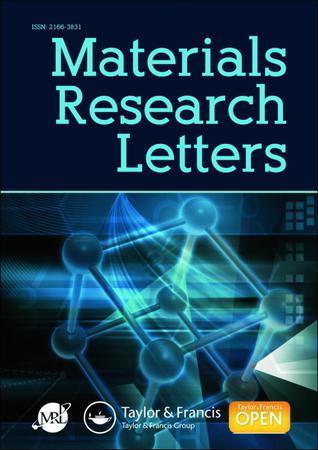用于电催化应用的高熵材料:第一性原理建模和模拟综述
IF 7.9
1区 材料科学
Q1 MATERIALS SCIENCE, MULTIDISCIPLINARY
引用次数: 3
摘要
高熵材料由于其结构的复杂性和性能的优越性,已被广泛证实是一种可能的先进电催化剂。已经做出了重大努力来对高熵催化剂的原子级细节进行建模,以提高先进电催化剂自下而上设计的可行性。在这篇综述中,首先,我们综述了基于密度泛函理论的各种建模方法的发展。我们综述了密度泛函理论模拟不同高熵电催化剂的进展。然后,我们回顾了高熵材料在电催化应用模拟方面的进展。最后,我们介绍了这一领域的前景。缩写:HEMs:高熵材料;CCM:成分复杂的材料;DFT:密度泛函理论;LDA:局部密度近似;GGA:广义梯度近似;VASP:维也纳从头算模拟包;ECP:有效的核心潜力;PAW:投影增强波电位;VCA:虚拟晶体近似;CPA:相干势近似;SQS:特殊的准随机结构;SSOS:有序结构的小集合;SLAE:类似的局部原子环境;HEAs:高熵合金;FCC:面心立方;BCC:体心立方;HCP:六方紧密堆积;ORR:氧还原反应;OER:氧化物析出反应;HER:析氢反应;RDS:速率限制步骤;AEM:吸附质演化机制;LOM:晶格氧氧化机理;HEOs:高熵氧化物;OVs:氧空位;PDOS:预测的状态密度;ADR:氨分解反应;NRR:氮还原反应;CO2RR:CO2还原反应;TMDC:过渡金属二硫族化合物;TM:过渡金属;AOR:醇氧化反应;GOR:甘油氧化反应;UOR:尿素氧化反应;HEI:高熵金属间化合物。图形摘要影响声明本文综述了高熵电催化剂原子模拟领域的最新进展,高熵电催化是一种新兴的最先进的催化材料。本文章由计算机程序翻译,如有差异,请以英文原文为准。
High-entropy materials for electrocatalytic applications: a review of first principles modeling and simulations
High-entropy materials, for both complexity in structure and superiority in performance, have been widely confirmed to be one possible kind of advanced electrocatalyst. Significant efforts have been dedicated to modeling the atomic-level details of high-entropy catalysts to improve the viability for bottom-up design of advanced electrocatalysts. In this review, first, we survey developments in various modeling methods that are based on density functional theory. We review progress in density functional theory simulations for emulating different high-entropy electrocatalysts. Then, we review the advancements in simulations of high-entropy materials for electrocatalytic applications. Finally, we present prospects in this field. Abbreviations: HEMs: high-entropy materials; CCMs: compositionally complex materials; DFT: density functional theory; LDA: local density approximation; GGA: generalized gradient approximation; VASP: Vienna Ab initio simulation package; ECP: effective core potential; PAW: projector-augmented wave potential; VCA: virtual crystal approximation; CPA: coherent potential approximation; SQS: special quasi-random structures; SSOS: small set of ordered structures; SLAE: similar local atomic environment; HEAs: high-entropy alloys; FCC: face-centered cubic; BCC: body-centered cubic; HCP: hexagonal close-packed; ORR: oxygen reduction reaction; OER: oxide evolution reaction; HER: hydrogen evolution reaction; RDS: rate-limiting step; AEM: adsorbate evolution mechanism; LOM: lattice oxygen oxidation mechanism; HEOs: high-entropy oxides; OVs: oxygen vacancies; PDOS: projected densities of states; ADR: ammonia decomposition reaction; NRR: nitrogen reduction reaction; CO2RR: CO2 reduction reaction; TMDC: transition metal dichalcogenide; TM: transition metal; AOR: alcohol oxidation reaction; GOR: glycerol oxidation reaction; UOR: urea oxidation reaction; HEI: high-entropy intermetallic. GRAPHICAL ABSTRACT IMPACT STATEMENT This paper reviews recent developments in the field of atomistic simulations of high-entropy electrocatalysts, one of emerging state-of-the-art catalytic materials.
求助全文
通过发布文献求助,成功后即可免费获取论文全文。
去求助
来源期刊

Materials Research Letters
Materials Science-General Materials Science
CiteScore
12.10
自引率
3.60%
发文量
98
审稿时长
3.3 months
期刊介绍:
Materials Research Letters is a high impact, open access journal that focuses on the engineering and technology of materials, materials physics and chemistry, and novel and emergent materials. It supports the materials research community by publishing original and compelling research work. The journal provides fast communications on cutting-edge materials research findings, with a primary focus on advanced metallic materials and physical metallurgy. It also considers other materials such as intermetallics, ceramics, and nanocomposites. Materials Research Letters publishes papers with significant breakthroughs in materials science, including research on unprecedented mechanical and functional properties, mechanisms for processing and formation of novel microstructures (including nanostructures, heterostructures, and hierarchical structures), and the mechanisms, physics, and chemistry responsible for the observed mechanical and functional behaviors of advanced materials. The journal accepts original research articles, original letters, perspective pieces presenting provocative and visionary opinions and views, and brief overviews of critical issues.
 求助内容:
求助内容: 应助结果提醒方式:
应助结果提醒方式:


